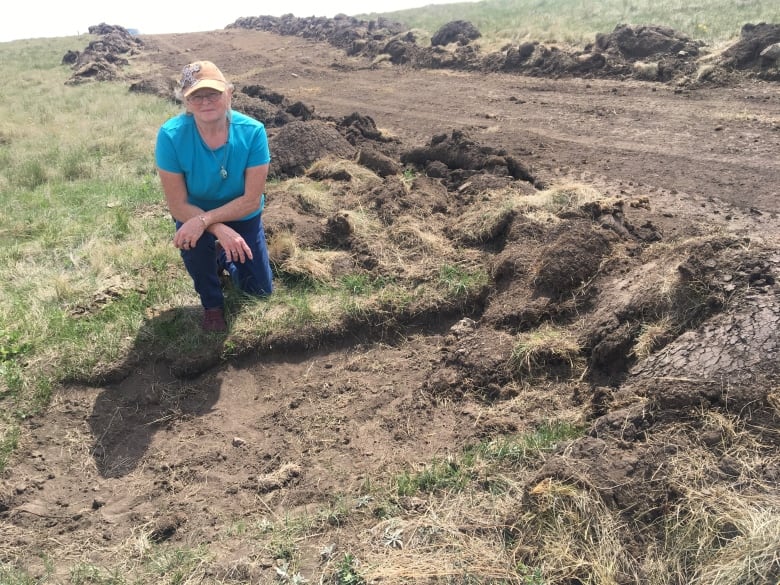Edgar Baptiste speaks to farmers, First Nations leaders and others following a pipe ceremony west of Biggar, Sask., Monday. Artifacts up to 10,000 years old were recently found there, including a piece of volcanic obsidian not native to Saskatchewan. A grid road is scheduled to be built at the site June 10. (Jason Warick/CBC)
A Saskatchewan road construction project is set to begin June 10 despite the discovery of Indigenous artifacts left there up to 10,000 years ago.
CBC News has obtained a Saskatchewan government document which details the significance of the find, but then grants the local municipality permission for construction.
“This office has no concern with the project proceeding as planned,” states the Heritage Conservation Branch letter.
First Nations elders and leaders say they’re shocked, given the urgent need for reconciliation in this area west of Saskatoon. They note Colten Boushie was killed less than 100 kilometres away, and Chief Poundmaker’s exoneration ceremony for his wrongful treason conviction was held just last month.
“It’s disturbing. This will make things worse,” Battlefords Agency Tribal Council executive director Neil Sasakamoose said.
“Don’t bulldoze our history. I’m personally just embarrassed and mad about it. I don’t know what emotion to express.”
Mitzi Gilroy kneels behind one of several spots on her ranch land where Indigenous artifacts were discovered. A grader came last week and partially plowed over the spot. (Jason Warick/CBC)
Sasakamoose said he can’t believe First Nations weren’t even notified about the discovery — they found out by chance from an area farmer.
Historian and Order of Canada recipient Bill Waiser said First Nations should have been told.
“The discovery of the site serves as a reminder that Saskatchewan history is actually quite ancient,” said Waiser, author of A World We Have Lost: Saskatchewan before 1905. “The site also confirms that early peoples had an extensive trade system. Some of the artifacts originated in other parts of North America.”
Saskatchewan Archaeological Society executive director Tomasin Playford said forging ahead with the road may be legal, but it’s wrong.
“I think there’s a moral obligation,” Playford said. “This is the material culture likely of descendants living today. They have a right to know about the site, and they should involved in any kind of decision-making process.”

Farmer Jim Gilroy, left, and former Red Pheasant Cree Nations Chief Sheldon Wuttunee share a laugh following a pipe ceremony Monday. The ceremony was held on the Gilroys’ land. (Don Somers/CBC)
A provincial government official said there’s no law requiring consultation with First Nations in these cases.
The official referred questions about the road’s status to the Rural Municipality of Winslow, but no one from the RM returned interview requests this week.
A few months ago, Mitzi and Jim Gilroy were told a new eight-kilometre gravel road would be crossing their ranch land 150 kilometres west of Saskatoon.
A private contracted archeologist was conducting a mandatory site survey. Mitzi Gilroy went to meet her in the field. She saw the rich discoveries made in just one day of digging up several small patches. The government letter confirms a further three-day dig and “specialist analysis” confirmed the value of the find.
The first layer contained more common artifacts such as pottery and a stone arrowhead, likely a few hundred years old.

A teepee-style structure was erected following a pipe ceremony Monday at one of several sites containing rare Indigenous artifacts in west-central Saskatchewan. (Don Somers/CBC)
Just below that was a second “very interesting” layer containing fragments of a stone spearhead or knife up to 10,000 years old, stated the letter. There was also a stone cairn with a small scraping tool that had been deliberately placed there.
The tool was made from obsidian, a rare glass-like volcanic rock traced to Wyoming’s Yellowstone National Park region, stated the letter.
“The obsidian would have been greatly valued for its unique qualities and was likely obtained through trade networks.”
Former Red Pheasant First Nation Chief Sheldon Wuttunee and others noted Wanuskewin Heritage Park outside Saskatoon could soon be declared a UNESCO World Heritage Site, and its history dates back an estimated 6,400 years.
Playford and Waiser note there are four or five Saskatchewan sites that also could be 9,000 to 10,000 years old, but those are several hundred kilometres south, near the U.S. border.
The Gilroys were surprised their land contained such rare artifacts.
“I was really amazed at what they found here,” Mitzi Gilroy said while giving CBC News a recent tour.
“To me, we’ve looked at this for how many years and what do you see? Oh some nice grass and stuff, but there was all these secrets buried here.”
Landowner Jim Gilroy, right, leads a group to the spot where rare Indigenous artifacts were recently unearthed. (Jason Warick/CBC)
They assumed the road construction would be cancelled or at least delayed, but it was not.
They were told construction would begin June 10. They asked a friend what to do, and he contacted Wuttunee.
Wuttunee, a champion powwow dancer and former high school teacher, said reconciliation and healing are a high priority for him. Wuttunee, who pleaded for calm after the shooting of Boushie and accompanied the Boushie family to lobby for change in Ottawa, tried to get all the parties together to talk about the road construction.
But shortly after Wuttunee and the Gilroys started asking questions last week, they made another discovery. They went out to the field and saw a grader had cut a wide swath through their land on the proposed road site. It partially destroyed at least one of the dig sites.
The Gilroys said they were told by the RM the work was needed to prevent brush fires from spreading, even though several centimetres of rain had just fallen.
Fearing destruction of the remaining sites, Wuttunee contacted elders, who suggested a First Nations pipe ceremony.
Monday morning, a convoy of trucks and vans drove to the edge of the site. The Gilroys, extended family members, neighbours and area First Nations people sat cross-legged in the grass adjacent to one of the dig spots. CBC News was invited to attend.
On the hot, windy day, with the Gilroys’ 60 Black Angus cattle watching from a distance, elders and their helpers passed the pipe and prayed for the spirits of those who had occupied that spot before them.

Federation of Sovereign Indigenous Nations vice-chief Edward Dutch Lerat praised the farm family who notified them about rare artifacts found on their land. He hopes legislation and public attitudes change to include First Nations.
Wutunee, Sasakamoose and Federation of Sovereign Indigenous Nations vice-chief Edward Dutch Lerat praised the Gilroys and the other farmers present. They say even if the site is destroyed, they at least had a chance to connect with the spirits.
“This site is very special should be celebrated and supported. That’s why we are here. We are calling on the province and the RM to join us and work together to preserve this,” Wuttunee said.
“It’s about learning to find balance and working together.”
The Gilroys’ neighbour, Tina Trotter, thanked Wuttunee for including her in the ceremony. She said the government and RM need to work with them.
“This is crazy,” Trotter said. “You’re ruining artifacts. This is foolhardy.”
After the ceremony, everyone headed back to the Gilroy farmhouse for lunch.
Tina Trotter’s land also sits on the proposed grid road route, and she also opposes it. She attended a pipe ceremony on neighbouring land Monday to show support for First Nations people trying to preserve the artifacts found there. (Jason Warick/CBC)
Many of them talked about the need to revamp Saskatchewan’s legislation around heritage sites. Control is often left in the RM’s hands, and First Nations have no rights.
Wuttunee, Sasakamoose and others have also been trying to track down the obsidian. The government confirmed to CBC News it’s in the hands of a private Saskatoon archeology company commissioned to do the site evaluation.
A written statement from Altheritage Services Corp. said all the rules are being followed, and they plan to ship the artifacts to the Royal Saskatchewan Museum in Regina. CBC News asked to view and photograph the artifacts. A company official said that could be arranged Wednesday.
Mitzi Gilroy said she hopes they can can help First Nations, and the entire province, to learn more about this piece of land.
“It’s simple,” she said. “It’s history. Don’t mess it up. Stop building.”














Leave a comment